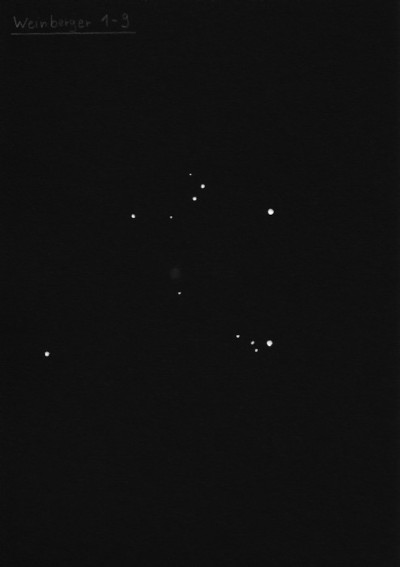A small and faint constellation of the northern sky south of the Swan, just off Albireo, north of the Sagitta and the Dolphin. The Vulpecula lies in the eastern stream of the summer Milky Way. Although the latter is not exceptionally bright in this region, it contains an abundant surplus of 7th to 10th magnitude stars. The star clouds are good for sweeping through with a binocular, and there are some nice objects to be discovered. The constellation contains a relatively large number of open clusters. The most impressive in the telescope's field of view is NGC 6940 , while the well-known open cluster Collinder 399, simply called "The Arm", is for any binoculars. There are also relatively bright nebulae, binaries, triple stars and, at the very eastern edge of the constellation, a few galaxies. The most famous object, however, is the planetary nebula M27 , one of the largest and brightest planetary nebulae, amazing in any telescope, from the binocular to big Dobsonian. Even with the smallest telescope, you can see a hint of its shape, from which it is also called - Dumbbell.
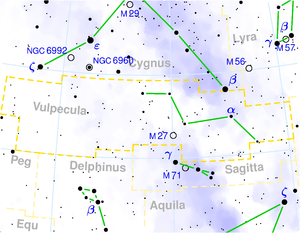
Struve 2653 - A binary star, in a telescope with an objective diameter of up to 150 mm, is a very close pair of unequally bright yellow-white stars (6.9 mag, 9.7 mag), which require appropriate magnification for resolution. They are separated by only 2.6".
Burnham 441 - This double star could be observed with a 100 mm telescope. It presents as a color contrast between a golden and blue component. The difference in magnitude is significant, with the golden component reaching 6.2 mag and the blue component only 10.7 mag. It is located at a separation of 5.9".
Struve 2455 - In a 100 mm telescope, the triple star is an attractive pair of one white and two bluish components. The brightest components (7.4 mag and 8.5 mag) are separated by 6.6". Half a degree to the NNE, in the same field of view, there is the double star Struve 2457, consisting of a white 7.5 mag component and a bluish 9 mag component, separated by 10.3".
Struve 2540 - Constellation. In a 100/150 mm instrument, a relatively close pair (5.1") consists of unequally bright white component of magnitude 7.3 and a blue component of magnitude 8.8. The companion of magnitude 12.4 is located 147" away.
M 27
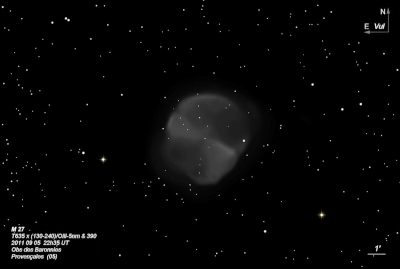
15x50 IS binoculars (multiple dates): easily the most prominent planetary visible in binoculars.
Charles Messier discovered M27 = NGC 6853 = h2060 on 12 July 1764. This was the first planetary nebula discovered. Caroline Herschel independently found it on 30 Sep 1782, her second night of sweeping. William Herschel reported "My sister discovered this nebula this evening in sweeping for comets; on comparing its place with Messier's nebulae we find it is his 27. It is very curious with a compound piece; the shape of it though oval as M. [Messier] calls it, is rather divided in two; it is situated among a number of small stars, but with this compound piece no star is visible in it. I can only make it bear 278. It vanishes with higher powers on account of its feeble light. With 278 the division between the two patches is stronger, because the intermediate faint light vanishes more." This discovery may have spurred WH to search for new nebulae.
On 19 Jul 1784, William Herschel recorded "The nebula in Vulpecula I suppose to be a double stratum of stars of a very great extent. The ends next to us are not only resolvable nebulosity, but I really do see very many of the stars mixt with the resolvable nebulosity; farther on the nebulosity is but barely resolvable and ends at last in milky whitishness of the same appearance as that in Orion. The idea I form of the shape of the nebula is ...[diagram follows]."
Lord Rosse's sketch from 21 Sep 1843 with his 36" was published in his 1844 PTRAS paper. He noted "Cannot say positively whether resolvable, but see through it an immense number of stars apparently united with nebulous matter. If they are stars seen through the neb and unconnected with it, it is strange they should be so much more numerous than in the adjoining part of the heavens." George Johnstone Stoney's sketch (started on 9 Sep, finished on the 16th) was published in the 1850 PT paper (figure 17). Bindon Stoney's sketch, with several superimposed and nearby stars, was based on micrometrical measurements and included in the 1861 monograph (figure 43). On 29 Aug 1854 during a return to Birr Castle, George Johnstone Stoney wrote a long note: "Both Dr. Robinson and I agreed that the beard of faint nebulosity extended farther down [sp?] than in my brother's drawing..."
As far as the nickname "Dumbbell" nebula, John Herschel wrote on 24 Aug 1827 "A most extraordinary object; vB; an unresolved nebula, shaped something like an hour-glass, filled into an oval outline with a much less dense nebulosity. The central mass may be compared to a vertebra or dumb-bell". In another sweep he describes the shape as "like a double-headed shot or a dumb-bell."
200/250mm - 8" (9/25/81): central star visible at 200x. The fainter side lobes are prominent.
400/500mm - 17.5" (6/15/91): very bright, very large, 7'x6', bright dumbbell lobes are oriented SSW-NNE. The SSW lobe is brighter with a bright outer rim. Large fainter sweeping side lobes fill in the dumbbell and reverse the major axis to WNW-ESE. The planetary has an irregular surface brightness with a darker center. At high power 5 or 6 stars are superimposed including the easy mag 13.8 central star. Overall, this is the most impressive planetary.
Notes by Steve Gottlieb
NGC 6940
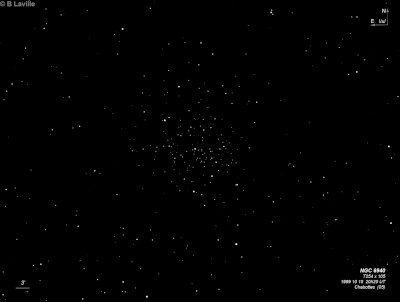
William Herschel discovered NGC 6940 = H VII-8 on 17 Jul 1784 (sweep 239) and recorded "a vL cl of scattered stars, very rich and most of the stars nearly of a size and pretty small. About 20' in diameter." His position is close to mag 8.3 HD 196244 on the northeast side of the cluster. On 18 Oct 1786 (sweep 615) he logged it as "a beautiful cl of scattered large stars, extremely rich, taking up near 1/2°."
300/350mm - 13.1" (7/27/84): beautiful rich star field although not dense. About 100 stars mag 9-14 resolved including the orange semii-regular variable star FG Vulpeculae near the center. The double star ∑2698 = 8.8/9.7 at 4.5" is off the southwest edge.
Notes by Steve Gottlieb
NGC 6842
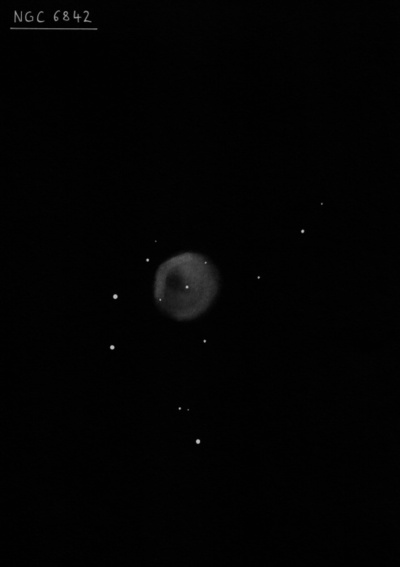
Albert Marth discovered NGC 6842 = m 403 = Sf 43 on 28 Jun 1863 and noted "vF, pL, R." Heinrich d'Arrest independently discovered it the following year on 26 Aug 1864 while searching for William Herschel's H. II-202 = NGC 6847. Truman Safford found the planetary again on 12 Jul 1866 with the 18.5-inch Clark refractor at Dearborn Observatory. See NGC 6847.
In 1919, Heber Curtis reported it was undoubtedly a planetary nebula based on a Crossley photograph and described it as "Very faint. It is about 50" x 45", showing traces of an irregular ring formation. It has a central star of about the 13th magnitude."
200/250mm - 8" off-axis mask (7/28/19): at 107x; very faint but definite unfiltered as a fairly small (~45"), roundish glow. Visible with direct vision when I added a NPB filter.
8" (9/81): I was surprised to glimpse NGC 6842 from home in El Cerrito (limiting mag of 4.5) using a Daystar 300 filter at 125x, even with black hood, averted vision and concentration. Walter Scott Houston wrote about this observation in detail in his Deep Sky Wonder's column of November 1982.
8" (7/31/81): extremely faint, fairly small, diffuse. Located in a rich star field.
300/350mm - 13.1" (7/12/86): at 62x and OIII filter appears moderately bright, moderately large, estimate V = 13.0. A mag 14.5 star is off the east edge. NGC 6834 lies 38' WNW.
400/500mm - 17.5" (8/7/91): fairly bright, moderately large, irregularly round, soft edges. A very faint mag 15.5 central star is visible and a second extremely faint mag 16.0 star is near the east edge. Several stars are at the edges including a mag 15-15.5 star at the NE edge and two mag 13-14 stars off the east side. Appears brighter around the central star.
600/800mm - 24" (9/1/16): at 375x and 500x (unfiltered); moderately bright and large, round, ~50" diameter, crisp edge to the rim, fairly evenly illuminated. The mag 15.5-16 central star was visible, along with several nearby stars; a mag 15.5 star is just off the NE edge [38" from center], a mag 15 star is off the south edge [47"] and a mag 14 star is off the east edge [50"]. Using 220x with a UHC filter, the planetary is fairly bright and the rim appears slightly brighter in sections.
Notes by Steve Gottlieb
NGC 6830
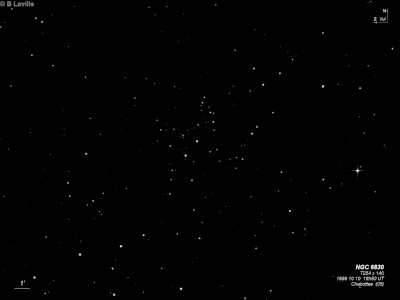
William Herschel discovered NGC 6830 = H VII-9 = h2052 on 19 Jul 1784 (sweep 241) and simply noted "a cluster of stars." On 17 Jul 1785 (sweep 415), he called this "a L cl of p compressed st, most of the same size, with many adjacent scattered ones." JH made the single observation "fine large coarse cl; fills field. Stars 11...12m, some outliers = 9, 10m." His position is in the center of the cluster.
400/500mm - 17.5" (8/8/91): 30-35 stars in the central 5' diameter. Most stars are mag 11-12 and arranged in two rows forming a rough "X" shape. The richest group is at the NW corner and a very faint group is off the SW corner. The brightest star is just SW of the intersection point of the "X". Located 30' N of 4.9-magnitude 12 Vulpeculae.
Notes by Steve Gottlieb
NGC 6885
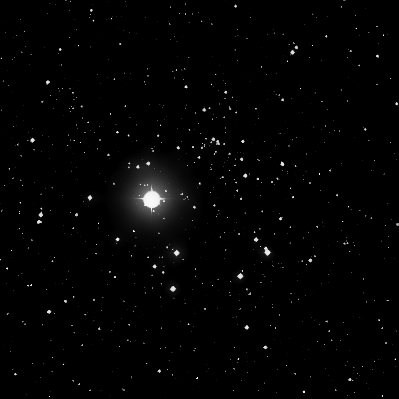
William Herschel discovered NGC 6885 = H VIII-20 = h2071 on 9 Sep 1784 (only discovery in sweep 261) and recorded "a cl of coarsely scattered stars, not very rich." His position is 6' west of 20 Vul, within the boundaries of the cluster. This same cluster was probably observed the next night and recorded as H VIII-22 = NGC 6882, but with a 15' error in declination. So, NGC 6882 = NGC 6885, though NGC 6882 is often taken as a richer subgroup on the northwest side of the cluster. JH made the single observation "Splendid cluster. More than fills the field; loose and straggling; poor in stars, one = 6.7m, whose place is given; the rest 9, 10, 11." Karl Harding found the cluster again in 1823 (probably with a 8.5-inch reflector built by WH, according to Wolfgang Steinicke) and included it in a list of discoveries he sent to Johann Bode.
200/250mm - 8" (8/23/84): about 50 stars at 100x, triangular-shaped, large, scattered, includes 20 Vulpeculae (V = 5.9). NGC 6882 is superimposed 5' N.
400/500mm - 17.5" (9/7/91): about 80 stars mag 6-13 in 15' triangular group, bright. Includes the bright star 20 Vulpeculae (V = 5.9) surrounded by seven very faint stars in the SE corner of the cluster. Weak in the center of the triangle except for about 10 other stars. A wide bright pair is at the east vertex and a wide unequal double star is at the SW side. Most stars are located along the west side particularly at the NW corner (this subgroup is catalogued as NGC 6882, although it may refer to the entire scattered group).
Notes by Steve Gottlieb
NGC 6802
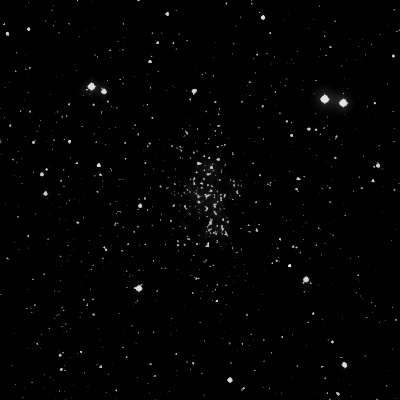
William Herschel discovered NGC 6802 = H VI-14 = h2042 on 11 Jul 1784 (sweep 235) and recorded "a cluster exceedingly small and v compressed stars, in the form of a parallelogram, about 4' l and nearly 2' broad; in the direction nearly of the meridian. But the weather is very hazy. On 18 Jul 1789 (sweep 932) he logged "a compressed cl of considerably small stars, very rich, about 5 or 6' l, 3' br, E nearly in the meridian." But Wolfgang Steinicke reports that Herschel first observed the cluster on 22 Sep 1783 with his 6.2-inch, before starting his sweeps.
On 8 Aug 1831 (sweep 364), John Herschel called it a "rectangular cluster; v m comp; 3' or 4' l; 2' br; stars 14...18m; among B stars."
200/250mm - 8" (10/4/80): bar-shaped N-S, faint, even surface brightness. A few mag 13 stars are resolved. Surrounded by two double stars to the west and north.
300/350mm - 13.1" (8/11/85): about two dozen stars are visible over extensive unresolved haze in an elongated N-S group. Located just east of the "Coathanger" asterism, in line with the long base of the Coatthanger.
Notes by Steve Gottlieb
NGC 6793
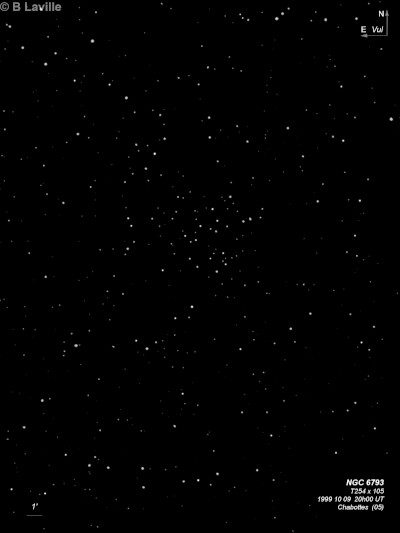
William Herschel discovered NGC 6793 = H VIII-81 = h2039 on 18 Jul 1789 (sweep 932) and recorded "a sc. cl. of cL stars, pretty rich, iF, above 15' in extent." His position is accurate. On 24 Aug 1827 (sweep 90), JH logged "place that of a double star (HJ 886) at the northern extremity of the more condensed part of a L, loose, poor cluster of st 10...15m."
400/500mm - 17.5" (9/7/91): three dozen stars mag 10.5-14 in a 8' field. Fairly distinctive in the field. Located within a 30' loose, indistinct group with a mag 8 star at the west edge. The core of the cluster contains a 1' triangle of mag 10.5-11 stars with the north vertex a nice double star (h886 = 10.5/11.5 at 8"). Just south is a 1' quadrilateral consisting of four mag 13 stars. No other distinct groups are in the cluster, although 4' N and 4' E are two small groups of seven and four stars.
Notes by Steve Gottlieb
NGC 6800
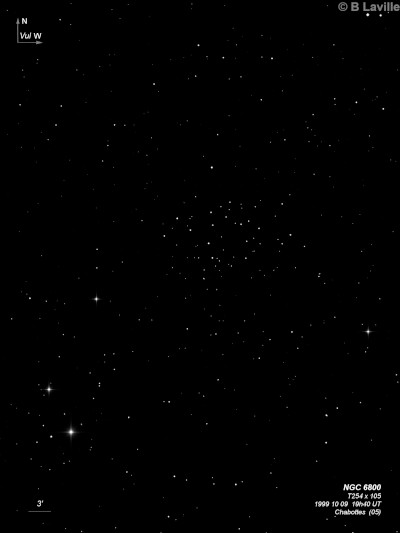
William Herschel discovered NGC 6800 = H VIII-21 = h2041 on 10 Sep 1784 (sweep 263) and logged "a cluster of coarsely scattered L stars intermixed with small stars." His position is on the northwest edge of the cluster. On 17 Jul 1785 (sweep 415), he called it "a coarsely scattered cl of considerately L stars, not rich." JH made a single observation, noting "vL; p rich; very straggling; stars 10m; fills field."
400/500mm - 17.5" (9/7/91): over 100 stars in a 25' field. Bright, very large, fairly rich in spots but not concentrated and very weak in the center. Bordered by a circular outline of mag 10-11 stars. A rich double group of about ten stars each is at the south side and includes a few bright stars and many faint stars. Off the west side is mag 7.7 SAO 87200 and mag 6.2 SAO 87190 is another 11' SW. Two rays of stars extend west of the main group. Located 35' NW of mag 4.4 Alpha Vulpeculae.
Notes by Steve Gottlieb
NGC 6823
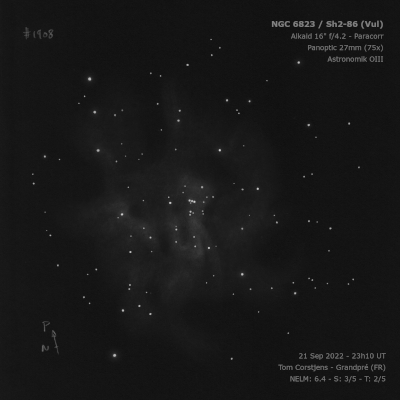
William Herschel discovered NGC 6823 = H VII-18 = h2049 on 17 Jul 1785 (sweep 415) and recorded "an elongated cluster of irregularly scattered stars of various sizes, considerably rich; the place taken is that of the brightest part of it, which is towards the south." JH made the single observation "p rich, irreg R; 5' diam; a cl of loose stars; the chief = 10m, the rest = 11...12. Four or five in centre [multiple star BD + 22 3782] form a lozenge."
400/500mm - 17.5" (8/10/91): about 50 stars in the central 5' diameter, bright, moderately large, fairly rich. Includes four bright mag 9.5-11 stars in a tight group at the core of the cluster plus two or three very faint stars in a 20" diameter. Most of the stars form a distinctive 5' oval ring, elongated ~E-W. Emission nebulosity Sh 2-86 (misidentified as NGC 6820 in most sources) is entwined.
Notes by Steve Gottlieb
NGC 6820
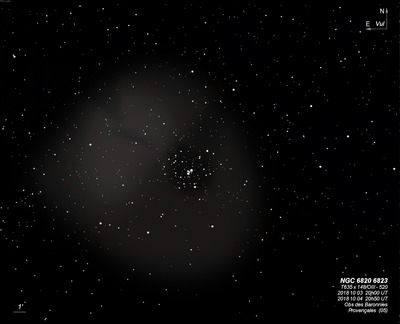
Albert Marth discovered NGC 6820 = m 401 on 7 Aug 1864 and noted "F, S, R, bM." This number is usually associated with the large HII region Sh 2-86 = LBN 135, but Marth's position (and Bigourdan's measurements) point to IRAS 19403 +2258, a compact knot at 19 42 27.9 +23 05 15 (J2000).
200/250mm - 8" (10/4/80): Sh 2-86 extremely faint nebulosity in field of NGC 6823. Involves four stars in the north and two stars in the south side.
300/350mm - 13.1" (8/15/82): cluster NGC 6823 is encased in nebulosity (Sh 2-86) using a filter and averted vision. Very difficult to identify the nebulosity unfiltered.
400/500mm - 17.5" (8/10/91): at 100x using OIII filter, open cluster NGC 6823 is immersed in a faint nebulosity. Also extends 5'-10' SW from the core of the cluster to a group of stars that wasn't included in the description of NGC 6823.
The observation above refers to Sh 2-86, the usual identification of NGC 6820. But based on Marth's position and description, NGC 6820 more likely refers to a compact knot to the southwest of the cluster at this position. At 220x, it appeared as a small, 20" knot surrounding a faint stellar or quasi-stellar core. Interestingly, this object dimmed with OIII, UHC and H-beta, so it's likely a reflection nebula that is detached from the main mass of nebulosity to the northeast.
Notes by Steve Gottlieb
IC 4954
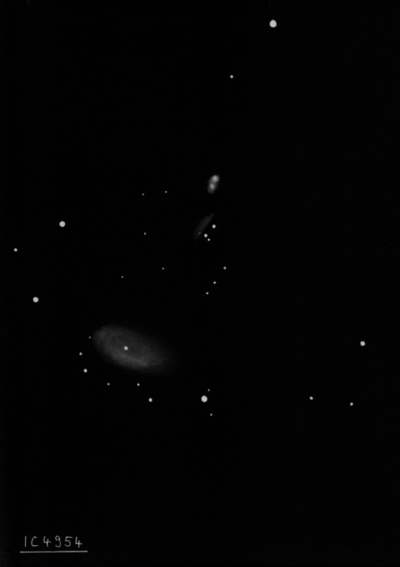
E.E. Barnard discovered IC 4954, along with IC 4955, on 9 Jun 1888 with the 12-inch refractor at Lick Observatory. He noted, "the north nebula [IC 4954] is not so well defined [as the south one] - that is the star is not. The star may be double, there is a faint star or separate patch (definition too bad to decide) close s.f. If the star is double, the components will be nearly n and s but not quite." He also viewed these reflection nebulae on 15 and 29 Jun, as well as 25 Jul 1888. The discovery was communicated directly to Dreyer.
400/500mm - 17.5" (9/26/92): this moderately bright reflection nebulosity forms a fairly striking compact pair with IC 4955 4' SE. Very small, round, 15"-20" diameter. Appears to surround a mag 13 star. A distinctive group of five stars (part of Roslund 4) just south are arranged in two parallel rows of three stars and two stars. No contrast gain with OIII or Deep Sky filter.
Notes by Steve Gottlieb
Cr 399
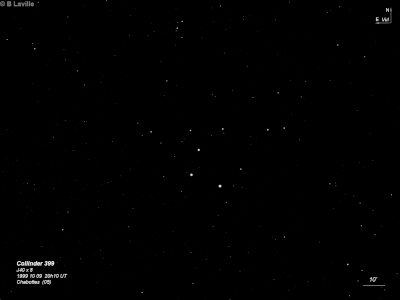
| Type | OC [III2p] |
| RA | 19:26:30.0 |
| Dec | +20:05:00.0 |
| major_axis | 140.0' |
| minor_axis | 50.0' |
| position_angle | 90.0 |
| mag | 3.6 |
Stock 1
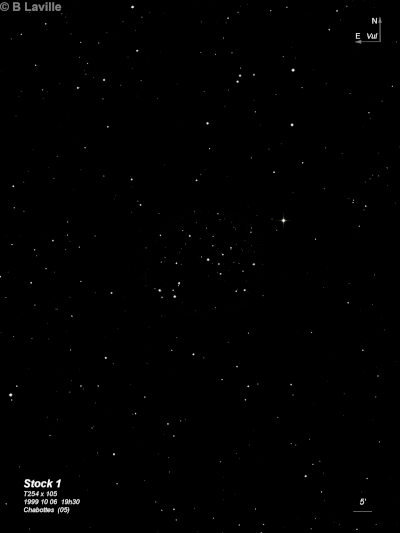
| Type | OC [III2m] |
| RA | 19:35:48.0 |
| Dec | +25:11:00.0 |
| major_axis | 60.0' |
| mag | 5.3 |
Abell 74
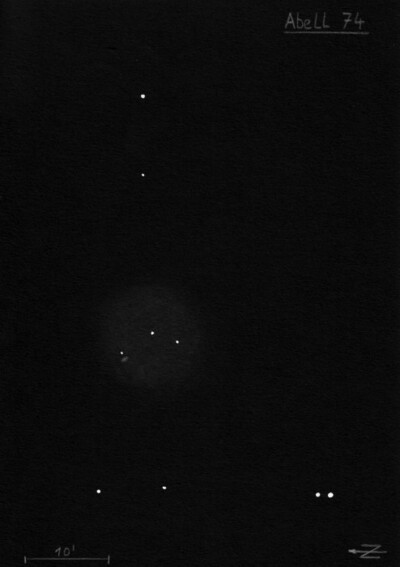
| Type | PN |
| RA | 21:16:52.3 |
| Dec | +24:08:51.0 |
| major_axis | 13.8' |
| mag | 12.2 |
| surface_bright | 17.7 |
Hen 1-6
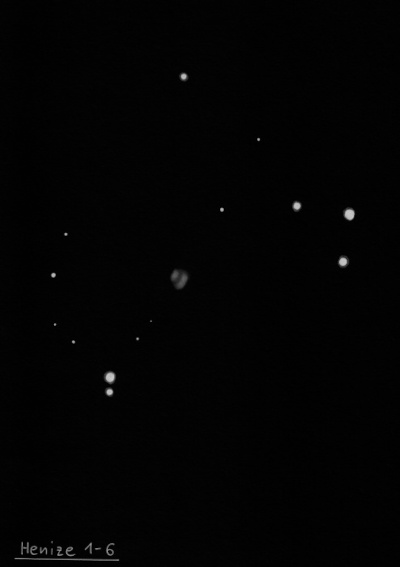
| Type | PN [3(2)] |
| RA | 20:17:21.4 |
| Dec | +25:21:47.0 |
| major_axis | 24.0'' |
| mag | 14.9 |
| surface_bright | 12.6 |
Hen 1-3
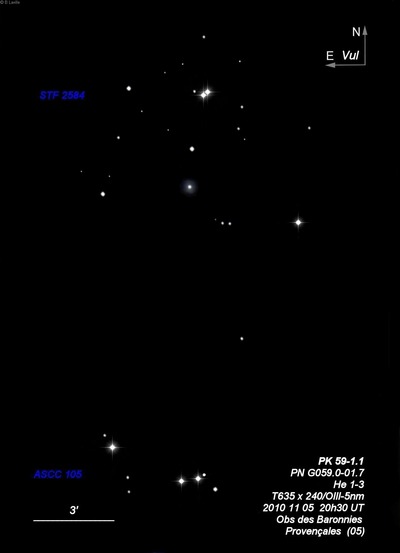
| Type | PN |
| RA | 19:48:26.4 |
| Dec | +22:08:37.0 |
| major_axis | 12.0'' |
| mag | 16.0 |
| surface_bright | 12.2 |
Abell 68
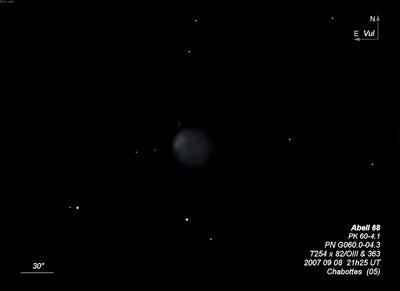
| Type | PN |
| RA | 20:00:10.6 |
| Dec | +21:42:55.0 |
| major_axis | 42.0'' |
| minor_axis | 36.0'' |
| mag | 16.6 |
| surface_bright | 15.4 |
Abell 57
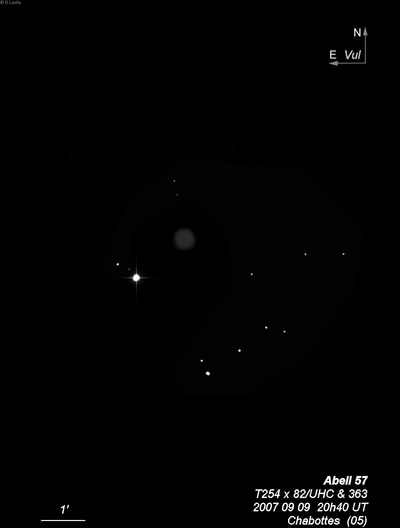
| Type | PN [3b] |
| RA | 19:17:05.7 |
| Dec | +25:37:33.0 |
| major_axis | 42.0'' |
| minor_axis | 36.0'' |
| mag | 17.5 |
| surface_bright | 16.2 |
